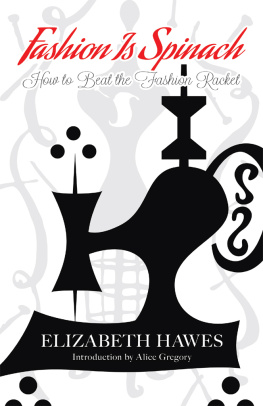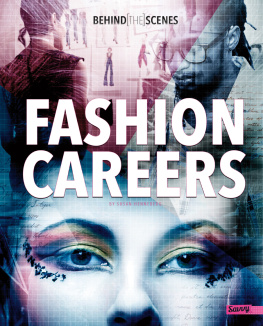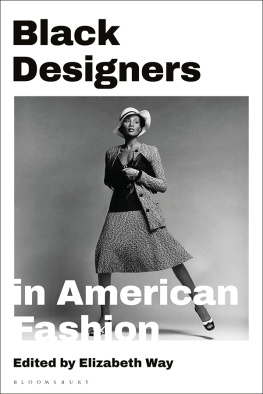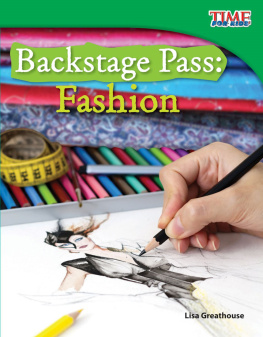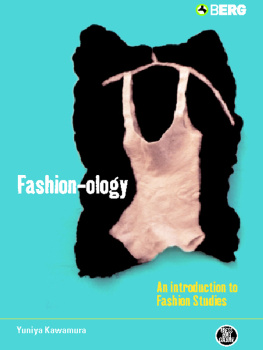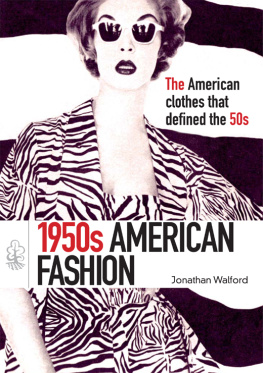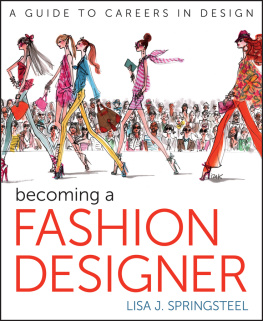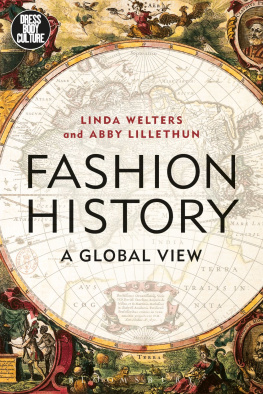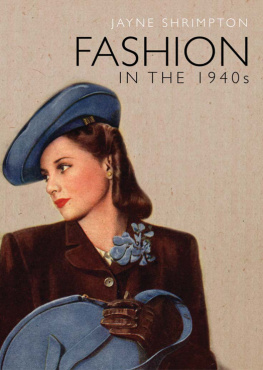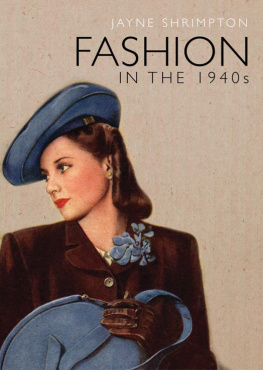Fashion Is Spinach
How to Beat the Fashion Racket
ELIZABETH HAWES
With a New Introduction by
Alice Gregory
Artwork by
Alexey Brodovitch

Dover Publications, Inc.
Mineola, New York
Copyright
Introduction copyright 2015 by Alice Gregory
All rights reserved.
Bibliographical Note
Fashion Is Spinach: How to Beat the Fashion Racket, first published by Dover Publications, Inc., in 2015, is an unabridged republication of the work originally published as Fashion Is Spinach by Random House, New York, in 1938. A new Introduction has been specially written by Alice Gregory for the Dover edition.
Library of Congress Cataloging-in-Publication Data
Hawes, Elizabeth, 19031971.
Fashion is spinach : how to beat the fashion racket / Elizabeth Hawes ; with a new introduction by Alice Gregory ; artwork by Alexey Brodovich.
p. cm.
An unabridged republication of the work originally published as Fashion Is Spinach, by Random House, New York, in 1938Title page verso.
eISBN-13: 978-0-486-80518-4
1. Hawes, Elizabeth, 19031971. 2. Women fashion designersNew York (State)New YorkBiography. 3. Fashion designersNew York (State) New YorkBiography. 4. Fashion designNew York (State)New York History20th century. 5. FashionUnited StatesHistory20th century. 6. Clothing and dressUnited StatesHistory20th century. 7. Clothing tradeUnited StatesHistory20th century. I. Title.
TT505.H35A3 2015
746.92092dc23
[B] 2014043485
Manufactured in the United States by Courier Corporation
79731701 2015
www.doverpublications.com

Eat your broccoli, dear.
I say its spinachand I say to hell
with it.
Illustration by courtesy of Carl Rose & The New Yorker
I acknowledge with gratitude the help
Of Maria Leiper who asked for another book
Of Harriette McLain who enabled Random House to print this book
Of Kenneth White who believes in split infinitives
All of whom made it possible for me to dedicate Fashion Is Spinach
TO
MADELEINE VIONNET
the great creator of style in France
AND TO
THE FUTURE DESIGNERS OF MASS-PRODUCED CLOTHES
the world over
Contents
PART I
THE FRENCH LEGEND
All beautiful clothes are made in the houses of the French couturires and all women want them.
PART II
BUY AMERICAN
All American women can have beautiful clothes.
INTRODUCTION
If one places ones faith in a meritocratic notion of creative successthat, by and large, the cream rises to the topthere is nothing more disconcerting than encountering the work of a truly great unknown. It seems to happen disproportionately on vacations: the moldering paperback left at the lake cabin by previous guests, the only subtitled DVD in the rented Parisian flat. With the discovery often comes a proprietary, unearned pride, the sense that it was more than just coincidence uniting you and the unjustly neglected artifact.
I did not find Fashion Is Spinach wedged between decorative pine cones at an Alpine ski chalet; it wasnt given to me offhandedly in high school by a Spanish-speaking host mother. Rather, an editor merely suggested, less than a year ago, that I look into Elizabeth Hawes. The backstory, such as it is, leaves much for a romantic imagination to desire. But lack of providence aside, reading Hawess words, I felt as though a divine gift had been bestowed upon me.
This was a woman who traveled the world, started businesses, understood her own industry in both a microscopic and panoramic way, and wrote with a confidence usually only seen in standup (male) comedians from the 1980s. There were phrases begging to be underlined on every page, aphorisms worthy of tombstones, advice Id like to remember to impart upon my future daughter. That this manifesto wasnt required reading in both business school and tenth-grade composition classes, beloved by economists and teenage girls alike, bewildered me. Fashion Is Spinach contains some of the funniest, truest, most perfectly pitched prose Ive ever read.
Elizabeth Hawes was born in Ridgewood, New Jersey, on December 16, 1903, the second of four children. Her father worked for a railroad company, and her mother, an early civil rights activist and proponent of Montessori schools, was employed by the Board of Education. The family was middle-class and lived in a modest, shingled house an hour outside of New York City. As a child, Hawes wove raffia baskets, constructed millinery for her Kewpie dolls, and made literally miles of beadwork, a hobby that often took her to the Museum of Natural History for design inspiration. As Hawes would recall as an adult, In spite of being too well clothed for any aesthetic pleasure in the winters, my childhood passed off quite painlessly. By the age of ten, she was sewing her own clothes; by age twelve, she was sewing clothes for other neighborhood girls. Hawes also had a precocious, if succinct, career selling childrens dresses to a shop in Pennsylvania, an activity she abandoned by the time she reached the ninth grade.
Hawes attended Vassar, majoring in economics and, for fun, designing costumes for school plays. The summer after her sophomore year, she secured what we would now call an unpaid internship in New York City at Bergdorf Goodman. After graduation, Hawes moved to Paris and got a job at a dressmakers shop on the Faubourg St. Honor, sewing illegal knockoffs of French designers wares.
Following her tutelage in the art of counterfeit couture, Hawes worked in various roles within the fashion industry: as a sketcher, a reporter, and a critic for The New Yorker (her nom de plume was Parasite). She returned to New York City in 1928, working as a stylist, a copywriter, and a buyer. At the age of twenty-five, she launched her own clothing line, Hawes-Harden. Her quickly tacking career always resisted stasis, and in middle age she moved to Detroit to work as a union organizer before decamping to the Caribbean. In 1971, at the age of sixty-six, Hawes died of liver cirrhosis in the Chelsea Hotel in Manhattan.
Over the course of her life, Hawes wrote a total of nine books: Fashion Is Spinach (1938), Men Can Take It (1939), Why Is A Dress? (1942), Good Grooming (1942), Why Women Cry, or Wenches with Wrenches (1943), Hurry Up Please, Its Time (1946), Anything But Love (1948), But Say It Politely (1954), and Its Still Spinach (1954). Alluntil noware out of print, and though each is laced with Hawess signature wit, plain-spokenness, self-deprecating prescriptivism, and egalitarian ideals, it is her first title that is most deserving of laurels.
Part memoir, part industry report, Fashion Is Spinach is built around the pernicious myth that everything chic is by legend French. The refrain that Hawes repeats throughout the bookAll beautiful clothes are designed in the house of the French couturiers and all women want those clothes serves as a kind of personal mantra: debunking it animates her life and work.
Hawes was American in the most positive, most old-fashioned sense: patriotic, un-snobbish, obsessed with hard work. No store can afford to get above the general level of its publics tastes, she wrote. Hawes believed that her fellow stateside females deserved to look and feel in their clothing the way everyone assumed only wealthy Europeans did and could. American women bear a lot, she wrote, as though sighing with profound sadness, and later: The butt of fashions dirtiest jokes is the public.

